key YAMAHA TDM 900 2003 User Guide
[x] Cancel search | Manufacturer: YAMAHA, Model Year: 2003, Model line: TDM 900, Model: YAMAHA TDM 900 2003Pages: 110, PDF Size: 7.38 MB
Page 27 of 110
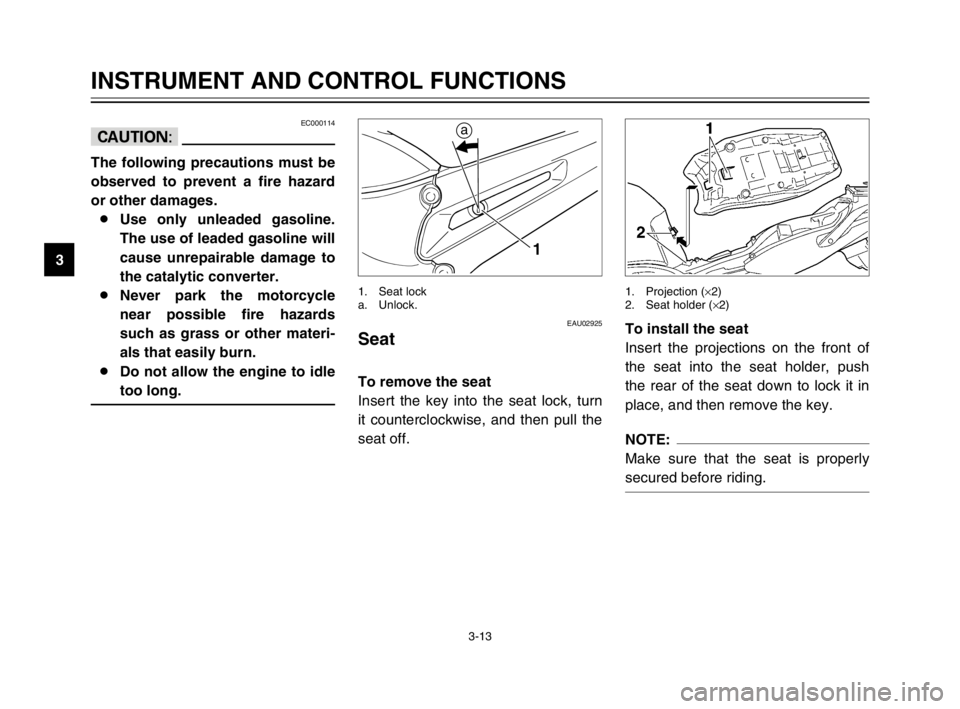
3-13
INSTRUMENT AND CONTROL FUNCTIONS
3
EC000114
cC
The following precautions must be
observed to prevent a fire hazard
or other damages.
8Use only unleaded gasoline.
The use of leaded gasoline will
cause unrepairable damage to
the catalytic converter.
8Never park the motorcycle
near possible fire hazards
such as grass or other materi-
als that easily burn.
8Do not allow the engine to idle
too long.
EAU02925
Seat
SeatTo remove the seat
Insert the key into the seat lock, turn
it counterclockwise, and then pull the
seat off.
1 a
1. Seat lock
a. Unlock.
To install the seat
Insert the projections on the front of
the seat into the seat holder, push
the rear of the seat down to lock it in
place, and then remove the key.
NOTE:
Make sure that the seat is properly
secured before riding.
1. Projection (×2)
2. Seat holder (×2)
5PS-28199-E1 8/29/02 9:16 AM Page 26
Page 34 of 110
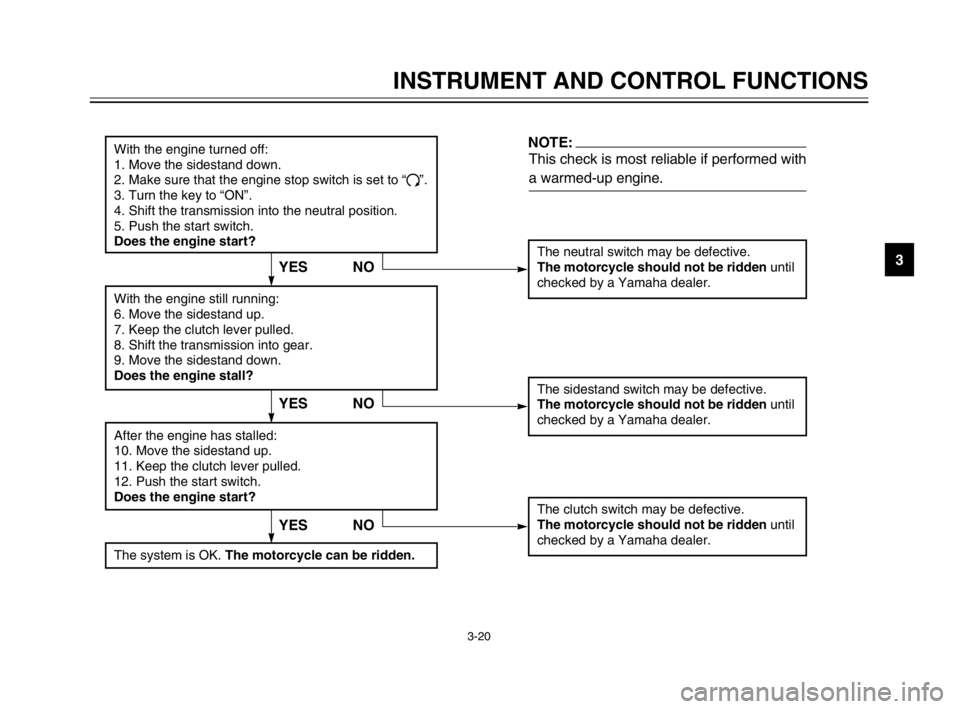
3-20
INSTRUMENT AND CONTROL FUNCTIONS
3
With the engine turned off:
1. Move the sidestand down.
2. Make sure that the engine stop switch is set to “
#”.
3. Turn the key to “ON”.
4. Shift the transmission into the neutral position.
5. Push the start switch.
Does the engine start?
The neutral switch may be defective.
The motorcycle should not be ridden until
checked by a Yamaha dealer.
With the engine still running:
6. Move the sidestand up.
7. Keep the clutch lever pulled.
8. Shift the transmission into gear.
9. Move the sidestand down.
Does the engine stall?
After the engine has stalled:
10. Move the sidestand up.
11. Keep the clutch lever pulled.
12. Push the start switch.
Does the engine start?
The sidestand switch may be defective.
The motorcycle should not be ridden until
checked by a Yamaha dealer.
The clutch switch may be defective.
The motorcycle should not be ridden until
checked by a Yamaha dealer.
NO
NOTE:
This check is most reliable if performed with
a warmed-up engine.
YES
YES NO
The system is OK. The motorcycle can be ridden.
YES NO
5PS-28199-E1 8/29/02 9:16 AM Page 33
Page 41 of 110
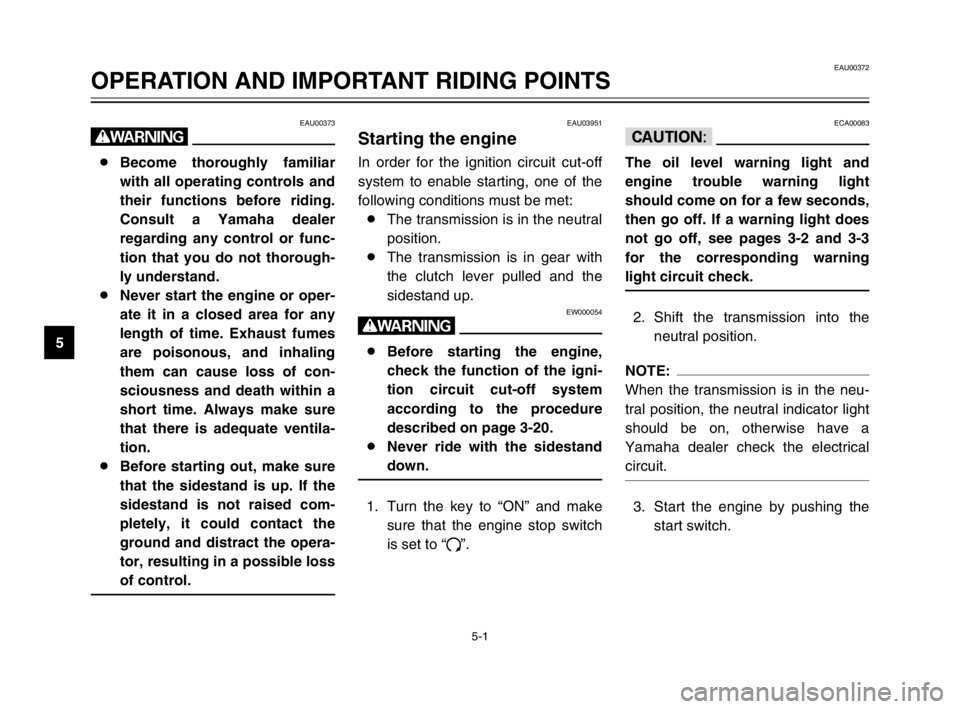
5-1
EAU00372
OPERATION AND IMPORTANT RIDING POINTS
5
EAU00373
w
8Become thoroughly familiar
with all operating controls and
their functions before riding.
Consult a Yamaha dealer
regarding any control or func-
tion that you do not thorough-
ly understand.
8Never start the engine or oper-
ate it in a closed area for any
length of time. Exhaust fumes
are poisonous, and inhaling
them can cause loss of con-
sciousness and death within a
short time. Always make sure
that there is adequate ventila-
tion.
8Before starting out, make sure
that the sidestand is up. If the
sidestand is not raised com-
pletely, it could contact the
ground and distract the opera-
tor, resulting in a possible loss
of control.
EAU03951
Starting the engineStarting the engineIn order for the ignition circuit cut-off
system to enable starting, one of the
following conditions must be met:
8The transmission is in the neutral
position.
8The transmission is in gear with
the clutch lever pulled and the
sidestand up.
EW000054
w
8Before starting the engine,
check the function of the igni-
tion circuit cut-off system
according to the procedure
described on page 3-20.
8Never ride with the sidestand
down.
1. Turn the key to “ON” and make
sure that the engine stop switch
is set to “#”.
ECA00083
cC
The oil level warning light and
engine trouble warning light
should come on for a few seconds,
then go off. If a warning light does
not go off, see pages 3-2 and 3-3
for the corresponding warning
light circuit check.
2. Shift the transmission into the
neutral position.
NOTE:
When the transmission is in the neu-
tral position, the neutral indicator light
should be on, otherwise have a
Yamaha dealer check the electrical
circuit.
3. Start the engine by pushing the
start switch.
5PS-28199-E1 8/29/02 9:16 AM Page 40
Page 44 of 110

5-4
OPERATION AND IMPORTANT RIDING POINTS
5
EAU04315
0–1,000 km
Avoid prolonged operation above
4,000 r/min.
1,000–1,600 km
Avoid prolonged operation above
6,000 r/min.
ECA00058
cC
After 1,000 km of operation, the
engine oil must be changed, and
the oil filter element replaced.
1,600 km and beyond
The vehicle can now be operated
normally.
EC000053
cC
8Keep the engine speed out of
the tachometer red zone.
8If any engine trouble should
occur during the engine break-
in period, immediately have a
Yamaha dealer check the vehi-
cle.
EAU00460
ParkingParkingWhen parking, stop the engine, and
then remove the key from the main
switch.
EW000058
w
8Since the engine and exhaust
system can become very hot,
park in a place where pedestri-
ans or children are not likely
to touch them.
8Do not park on a slope or on
soft ground, otherwise the
motorcycle may overturn.
5PS-28199-E1 8/29/02 9:16 AM Page 43
Page 80 of 110

6-34
PERIODIC MAINTENANCE AND MINOR REPAIR
6 To store the battery
1. If the motorcycle will not be used
for more than one month,
remove the battery, fully charge
it, and then place it in a cool, dry
place.
2. If the battery will be stored for
more than two months, check it
at least once a month and fully
charge it if necessary.
3. Fully charge the battery before
installation.
4. After installation, make sure that
the battery leads are properly
connected to the battery termi-
nals.
EAU04880
Replacing the fusesFuses, replacingThe main fuse and the fuse box,
which contains the fuses for the indi-
vidual circuits, are located under the
seat. (See page 3-13 for seat
removal and installation procedures.)
If a fuse is blown, replace it as fol-
lows.
1. Turn the key to “OFF” and turn
off the electrical circuit in ques-
tion.
12 34 5 689 7
7
1. Odometer and clock fuse (backup fuse)
2. Radiator fan fuse
3. Turn signal light and hazard fuse
4. Ignition fuse
5. Signaling system fuse
6. Headlight fuse
7. Spare fuse (×5)
8. Electronic fuel injection system fuse
9. Main fuse
EC000102
cC
8Always keep the battery
charged. Storing a discharged
battery can cause permanent
battery damage.
8To charge a sealed-type (MF)
battery, a special (constant-
voltage) battery charger is
required. Using a conventional
battery charger will damage
the battery. If you do not have
access to a sealed-type (MF)
battery charger, have a
Yamaha dealer charge your
battery.
5PS-28199-E1 8/29/02 9:17 AM Page 79
Page 81 of 110
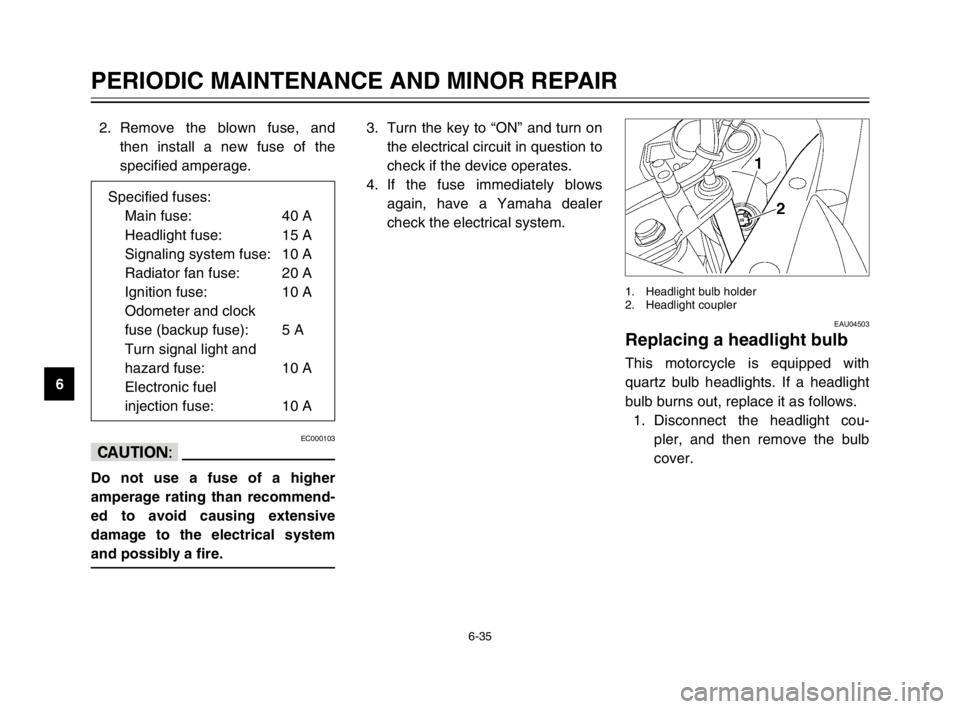
6-35
PERIODIC MAINTENANCE AND MINOR REPAIR
62. Remove the blown fuse, and
then install a new fuse of the
specified amperage.
EC000103
cC
Do not use a fuse of a higher
amperage rating than recommend-
ed to avoid causing extensive
damage to the electrical system
and possibly a fire.
EAU04503
Replacing a headlight bulbHeadlight bulb, replacingThis motorcycle is equipped with
quartz bulb headlights. If a headlight
bulb burns out, replace it as follows.
1. Disconnect the headlight cou-
pler, and then remove the bulb
cover.
1. Headlight bulb holder
2. Headlight coupler
3. Turn the key to “ON” and turn on
the electrical circuit in question to
check if the device operates.
4. If the fuse immediately blows
again, have a Yamaha dealer
check the electrical system. Specified fuses:
Main fuse: 40 A
Headlight fuse: 15 A
Signaling system fuse: 10 A
Radiator fan fuse: 20 A
Ignition fuse: 10 A
Odometer and clock
fuse (backup fuse): 5 A
Turn signal light and
hazard fuse: 10 A
Electronic fuel
injection fuse: 10 A
5PS-28199-E1 8/29/02 9:17 AM Page 80
Page 104 of 110
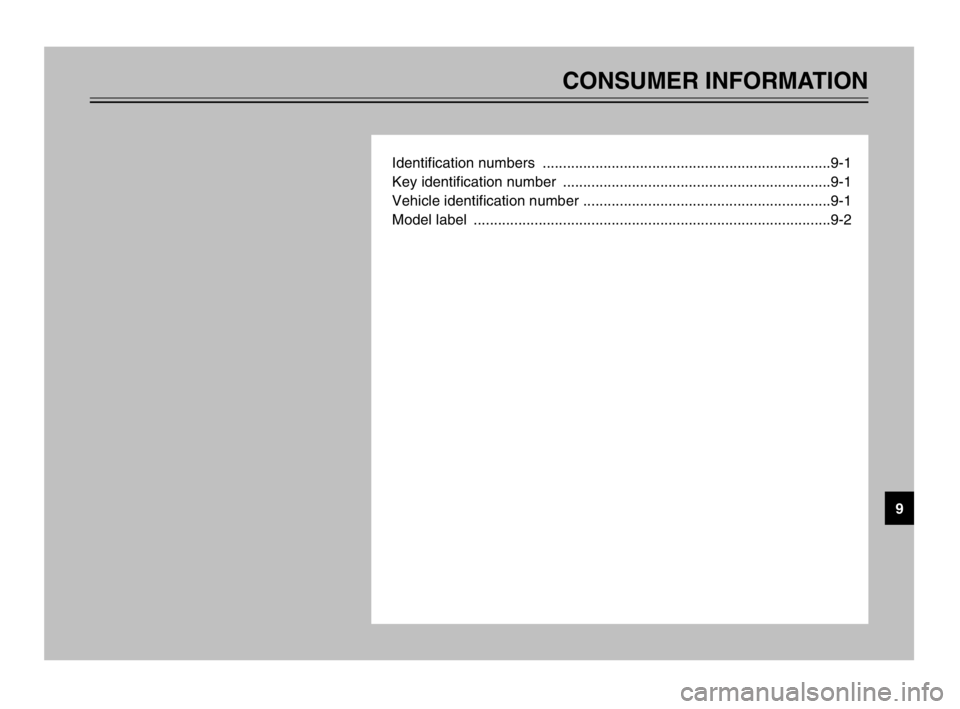
CONSUMER INFORMATION
Identification numbers .......................................................................9-1
Key identification number ..................................................................9-1
Vehicle identification number .............................................................9-1
Model label ........................................................................................9-2
9
5PS-28199-E1 8/29/02 9:17 AM Page 103
Page 105 of 110

9
9-1
EAU01039
CONSUMER INFORMATION
EAU02944
Identification numbersIdentification numbersRecord the key identification number,
vehicle identification number and
model label information in the spaces
provided below for assistance when
ordering spare parts from a Yamaha
dealer or for reference in case the
vehicle is stolen.
1. KEY IDENTIFICATION
NUMBER:
2. VEHICLE IDENTIFICATION
NUMBER:
3. MODEL LABEL INFORMATION:
EAU01043
Vehicle identification numberVehicle identification numberThe vehicle identification number is
stamped into the steering head pipe.
Record this number in the space pro-
vided.
NOTE:
The vehicle identification number is
used to identify your motorcycle and
may be used to register your motor-
cycle with the licensing authority in
your area.
1. Identification number
EAU01041
Key identification numberKey identification numberThe key identification number is
stamped into the key tag.
Record this number in the space pro-
vided and use it for reference when
ordering a new key.
1. Key identification number
1
6
5PS-28199-E1 8/29/02 9:17 AM Page 104
Page 107 of 110
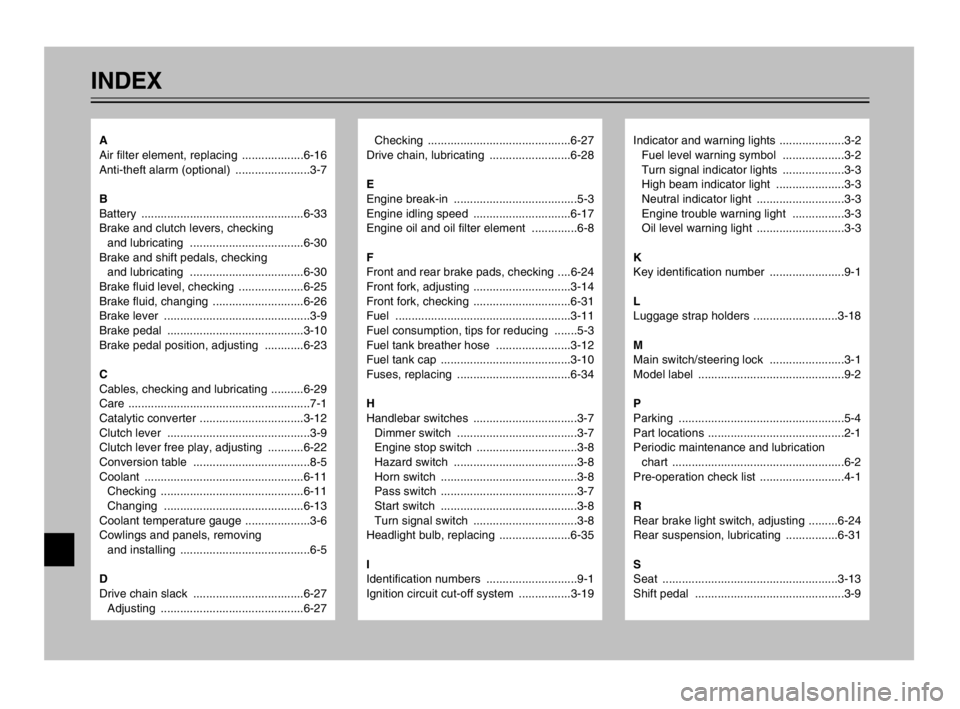
INDEX
Checking ............................................6-27
Drive chain, lubricating .........................6-28
E
Engine break-in ......................................5-3
Engine idling speed ..............................6-17
Engine oil and oil filter element ..............6-8
F
Front and rear brake pads, checking ....6-24
Front fork, adjusting ..............................3-14
Front fork, checking ..............................6-31
Fuel ......................................................3-11
Fuel consumption, tips for reducing .......5-3
Fuel tank breather hose .......................3-12
Fuel tank cap ........................................3-10
Fuses, replacing ...................................6-34
H
Handlebar switches ................................3-7
Dimmer switch .....................................3-7
Engine stop switch ...............................3-8
Hazard switch ......................................3-8
Horn switch ..........................................3-8
Pass switch ..........................................3-7
Start switch ..........................................3-8
Turn signal switch ................................3-8
Headlight bulb, replacing ......................6-35
I
Identification numbers ............................9-1
Ignition circuit cut-off system ................3-19Indicator and warning lights ....................3-2
Fuel level warning symbol ...................3-2
Turn signal indicator lights ...................3-3
High beam indicator light .....................3-3
Neutral indicator light ...........................3-3
Engine trouble warning light ................3-3
Oil level warning light ...........................3-3
K
Key identification number .......................9-1
L
Luggage strap holders ..........................3-18
M
Main switch/steering lock .......................3-1
Model label .............................................9-2
P
Parking ...................................................5-4
Part locations ..........................................2-1
Periodic maintenance and lubrication
chart .....................................................6-2
Pre-operation check list ..........................4-1
R
Rear brake light switch, adjusting .........6-24
Rear suspension, lubricating ................6-31
S
Seat ......................................................3-13
Shift pedal ..............................................3-9A
Air filter element, replacing ...................6-16
Anti-theft alarm (optional) .......................3-7
B
Battery ..................................................6-33
Brake and clutch levers, checking
and lubricating ...................................6-30
Brake and shift pedals, checking
and lubricating ...................................6-30
Brake fluid level, checking ....................6-25
Brake fluid, changing ............................6-26
Brake lever .............................................3-9
Brake pedal ..........................................3-10
Brake pedal position, adjusting ............6-23
C
Cables, checking and lubricating ..........6-29
Care ........................................................7-1
Catalytic converter ................................3-12
Clutch lever ............................................3-9
Clutch lever free play, adjusting ...........6-22
Conversion table ....................................8-5
Coolant .................................................6-11
Checking ............................................6-11
Changing ...........................................6-13
Coolant temperature gauge ....................3-6
Cowlings and panels, removing
and installing ........................................6-5
D
Drive chain slack ..................................6-27
Adjusting ............................................6-27
5PS-28199-E1 8/29/02 9:17 AM Page 106